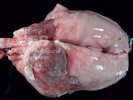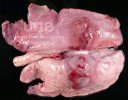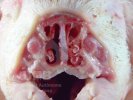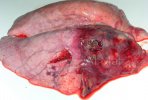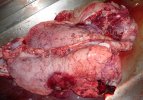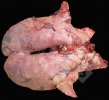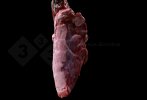Pasteurellosis
Pasteurella multocida is usually the cause of pneumonia as secondary infection to another respiratory pathogen (enzootic pneumonia, PRRS, flu)
Alternative names: Pasteurella multocida typeA
Information
Pasteurella multocida type A strains are usually involved in respiratory diseases in swine. They cannot cause pneumonia on their own, but are usually opportunistic infections, associated with enzootic pneumonia infections, PRRS, or influenza. Pasteurella multocida infections do cause significant lung damage in co-infections making it a significant pathogen of the respiratory system of swine.
Symptoms
The acute disease is characterized by:
- Severe acute pneumonia.
- High fever.
- Nasal discharge.
- High mortality.
- Accelerated breathing.
The sub-acute disease is characterized by:
- Less severe pneumonia which is usually complicated with pericarditis and pleuritis.
- Cough.
- Nasal discharge.
- Emaciation.
- Increase in mortality.
Causes / Contributing Factors
Concurrent diseases such as PRRS, influenza and enzootic pneumonia predispose the disease.
Diagnosis
Based in post-mortem examinations and isolation of the organism from lung samples. Antibiograms are important in helping select the right antibiotic for treating respiratory disease outbreaks.
Control/Prevention
- Many times, viral pneumonia is treated with antibiotics to treat or prevent pneumonia caused by Pasteurella infection.
- Vaccines against Pasteurella have not been very effective in the past.
- Controlling primary pathogens is critical in minimizing the need for antibiotic use in swine respiratory disease outbreaks.


